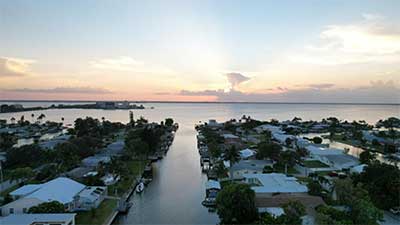The exterior of your home or business takes a beating from harsh weather, UV rays, and other environmental factors that can cause paint to fade. Believe it or not, fading paint not only reduces curb appeal, but also signals a more vulnerable exterior. Fading paint can lead to peeling, chalking, and other issues that demand frequent touch-ups and repairs. By taking steps to prevent paint from fading, you maintain the aesthetic appeal and structural integrity of your property. Below are our top tips for keeping your paint as fresh as the day you painted it:
Key Takeaways
- Invest in high-quality exterior paints to prevent a fading exterior paint color.
- Choose lighter colors to reflect sunlight and maintain the integrity of your exterior paints.
- Proper surface preparation and primer application enhance the durability of both exterior and interior paint jobs.
- Use UV-resistant products to protect against sun damage and maintain vibrant colors.
- Regular cleaning removes dirt and pollutants that can degrade exterior paints.
- Protect your exterior paint with awnings, covers, and natural shade from trees.
Steps to Stop Exterior Paint Fading
1. Invest in High-Quality Paint
High-quality exterior paint is essential for a durable and long-lasting paint job. Though more expensive, these paints offer better value over time by reducing the need for frequent repaints. They have superior durability, UV resistance, and adhesion, allowing them to withstand harsh sunlight, rain, wind, and other weather conditions without quickly deteriorating. Plus, they contain fade-resistant pigments that help maintain the paint color longer.
Latex vs. Oil-Based Paints: Which is Better?
Latex Paints: Water-based latex paints offer excellent flexibility and breathability, making them ideal for various exterior surfaces. They are easy to clean, dry quickly, and are less prone to cracking and peeling than oil-based paints.
Oil-Based Paints: These provide a smoother finish and are more durable in extreme weather conditions. However, they take longer to dry and are more challenging to clean up.
2. Choose the Right Paint for Your Climate
Humid or Rainy Climates: Latex paints are recommended due to their resistance to moisture and mildew.
Dry, Sunny Environments: Oil-based paints might be preferred for their superior durability against UV rays.
3. Opt for UV-Resistant Products
UV-resistant paints are specially formulated to resist the damaging effects of UV radiation. These fade-resistant paints contain reflective properties that help prevent the paint color from deteriorating under direct sunlight.
4. Pick a Reflective Paint Sheen
Reflective sheens, like semi-gloss or gloss, help to reflect more sunlight, reducing the amount of UV light absorbed by the paint. This helps maintain the paint color and prevent it from fading quickly. While flat paint can be aesthetically pleasing, it tends to absorb more light and may fade faster.
5. Choose Lighter Paint Colors
Lighter colors reflect more sunlight and absorb less heat, maintaining the paint’s integrity over time. Darker colors, such as dark blues and reds, absorb more UV rays and tend to fade faster. Choosing lighter colors, like earth tones, can extend the life of your exterior paint job and reduce the need for frequent repaints.
6. Prepare the Surface Properly
Proper surface preparation is key to making your exterior paint last longer and more resistant to fading. Start by thoroughly cleaning the exterior surfaces to remove dirt, mildew, and loose paint. Sanding the surface helps create a smooth and even base for the paint to adhere to, ensuring better adhesion and durability.
7. Use a High-Quality Primer
Applying a high-quality primer before painting is crucial for a durable exterior paint job. Primer helps seal the surface, provide a uniform base for the topcoat, and improve adhesion. It also enhances the paint’s durability and resistance to fading by creating a solid foundation.
8. Apply Multiple Coats of Paint
Applying multiple coats of paint enhances the durability and longevity of the paint film. Each coat adds a layer of protection, helping to prevent peeling paint and extend the life of the paint job. Multiple coats also ensure a more uniform and vibrant finish.
9. Protect Your Paint with Awnings and Covers
One effective strategy to protect your exterior paint job from fading is to use physical barriers such as awnings and covers. These structures provide a shield against harsh sunlight, UV rays, and other environmental factors that can cause paint fading. By installing awnings over windows and doors, you can reduce direct exposure to sunlight, thereby extending the life of your exterior paint and maintaining its vibrant color.
10. Trees for Natural Shade
Believe it or not, planting trees around your home is a great way to protect your exterior surfaces. Trees provide natural shade, reducing the amount of direct sunlight hitting your walls and minimizing the risk of paint fading. Plus, they enhance your curb appeal and offer environmental benefits like improved air quality and lower energy costs.
11. Regular Cleaning to Remove Dirt and Pollutants
With that in mind, keeping your exterior surfaces clean is crucial. Dirt, dust, and pollutants can accumulate on the paint, leading to discoloration and degradation over time. To keep your paint looking fresh, wash your exterior at least once a year. Use a gentle cleaning solution and a soft brush or sponge. Avoid high-pressure washers that can damage the paint film. Regular cleaning not only helps maintain the paint color but also prolongs the life of your paint job.
What Causes Exterior Paint to Fade?
Exposure to UV Rays: One of the main reasons exterior paint fades is due to UV rays. Direct sunlight breaks down the chemical bonds in paint pigments, causing the color to fade. This effect is especially noticeable in darker colors and low-quality paints. High-quality paints with fade-resistant formulations are designed to withstand UV radiation better and maintain their color longer.
Weather Conditions: Harsh weather, like rain, wind, and extreme temperatures, also contributes to paint fading. These elements can erode the paint film, leading to a loss of color and integrity. For instance, repeated wetting and drying cycles can cause paint to crack and peel, exposing the underlying surface to further damage. While high-quality exterior paints are formulated to resist these conditions, regular maintenance and proper application techniques are still necessary.
Low-Quality Paint: Using low-quality paint is another significant factor in paint fading. Low-quality paints often contain inferior pigments and binders that are less resistant to environmental stressors. This results in a paint job that fades quickly and requires more frequent touch-ups. Investing in high-quality paints with strong pigments and binders can prevent premature fading and provide a more durable finish.
Improper Application Techniques: Improper application techniques can speed up the fading process. Applying paint too thinly, not allowing adequate drying time between coats, or failing to properly prepare the surface can all lead to a shorter lifespan for the paint job. Ensuring the paint is applied correctly, with appropriate surface preparation and sufficient coats, is essential to prevent exterior paint from fading prematurely.
Negative Effects of Fading Paint
Aesthetics: A primary reason to be concerned about fading exterior paint is the impact on aesthetics. Faded paint diminishes the visual appeal of your property, making it look neglected and older than it is. A vibrant, well-maintained paint job enhances the curb appeal of your home or commercial property, making a positive impression on visitors and potential buyers.
Protection of the Underlying Structure: Beyond looks, exterior paint acts as a protective barrier for your home’s exterior surfaces. When paint fades and deteriorates, it can lead to more serious issues like peeling paint, which exposes the underlying structure to moisture and other damaging elements. This can result in costly repairs and compromise the integrity of the building.
Impact on Property Value: Fading exterior paint can also negatively impact the value of your property. A well-maintained exterior suggests that the property has been cared for, which is attractive to buyers and can increase the property’s market value. Conversely, a faded and deteriorating exterior can lower the perceived value and deter potential buyers.
Conclusion
By following these top tips, you can significantly extend the life of your exterior paint and keep your property looking its best. From investing in high-quality, UV-resistant paints to choosing lighter colors and maintaining a clean surface, these proactive measures will help prevent fading and protect your home or business from the elements. Remember, a vibrant and well-maintained exterior not only enhances curb appeal but also preserves the structural integrity and value of your property. Keep your paint fresh and your property protected for years to come!



















